小学英语语法精品教案
小学英语语法课教案模板及范文
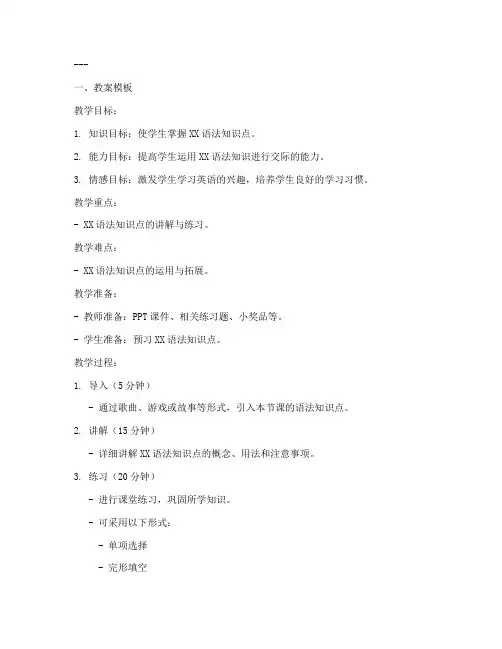
---一、教案模板教学目标:1. 知识目标:使学生掌握XX语法知识点。
2. 能力目标:提高学生运用XX语法知识进行交际的能力。
3. 情感目标:激发学生学习英语的兴趣,培养学生良好的学习习惯。
教学重点:- XX语法知识点的讲解与练习。
教学难点:- XX语法知识点的运用与拓展。
教学准备:- 教师准备:PPT课件、相关练习题、小奖品等。
- 学生准备:预习XX语法知识点。
教学过程:1. 导入(5分钟)- 通过歌曲、游戏或故事等形式,引入本节课的语法知识点。
2. 讲解(15分钟)- 详细讲解XX语法知识点的概念、用法和注意事项。
3. 练习(20分钟)- 进行课堂练习,巩固所学知识。
- 可采用以下形式:- 单项选择- 完形填空- 句型转换- 小组讨论4. 拓展(10分钟)- 引导学生运用所学语法知识进行拓展练习,如:- 创作小故事- 角色扮演- 制作海报5. 总结(5分钟)- 回顾本节课所学内容,强调重点和难点。
- 鼓励学生课后复习,巩固所学知识。
6. 作业布置(5分钟)- 布置与XX语法知识点相关的课后作业。
二、范文课题:一般现在时教学目标:1. 知识目标:使学生掌握一般现在时的概念、构成和用法。
2. 能力目标:提高学生运用一般现在时进行交际的能力。
3. 情感目标:激发学生学习英语的兴趣,培养学生良好的学习习惯。
教学重点:- 一般现在时的构成和用法。
教学难点:- 一般现在时的否定句和疑问句的构成。
教学准备:- 教师准备:PPT课件、相关练习题、小奖品等。
- 学生准备:预习一般现在时。
教学过程:1. 导入- 通过歌曲《Happy》引入一般现在时。
2. 讲解- 详细讲解一般现在时的概念、构成和用法。
- 举例说明一般现在时的肯定句、否定句和疑问句。
3. 练习- 进行课堂练习,巩固所学知识。
- 可采用以下形式:- 单项选择- 完形填空- 句型转换4. 拓展- 引导学生运用所学语法知识进行拓展练习,如: - 创作小故事- 角色扮演5. 总结- 回顾本节课所学内容,强调重点和难点。
小学英语语法课教案.doc
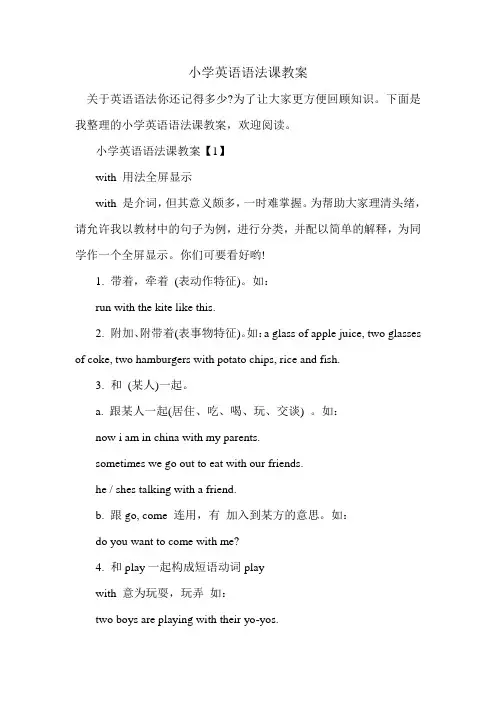
小学英语语法课教案关于英语语法你还记得多少?为了让大家更方便回顾知识。
下面是我整理的小学英语语法课教案,欢迎阅读。
小学英语语法课教案【1】with 用法全屏显示with 是介词,但其意义颇多,一时难掌握。
为帮助大家理清头绪,请允许我以教材中的句子为例,进行分类,并配以简单的解释,为同学作一个全屏显示。
你们可要看好哟!1. 带着,牵着(表动作特征)。
如:run with the kite like this.2. 附加、附带着(表事物特征)。
如:a glass of apple juice, two glasses of coke, two hamburgers with potato chips, rice and fish.3. 和(某人)一起。
a. 跟某人一起(居住、吃、喝、玩、交谈) 。
如:now i am in china with my parents.sometimes we go out to eat with our friends.he / shes talking with a friend.b. 跟go, come 连用,有加入到某方的意思。
如:do you want to come with me?4. 和play一起构成短语动词playwith 意为玩耍,玩弄如:two boys are playing with their yo-yos.5. 与help 一起构成help...with...句式,意为帮助(某人) 做(某事)。
如:on monday and wednesday, he helps his friends with their english.6. 表示面部神情,有含着,带着如:im late for school, said sun yang, with tears in his eyes.7. 表示用如:you play it with your feet.what do the farmers do with your machines?8. 表示对,关于。
小学英语基础语法教案
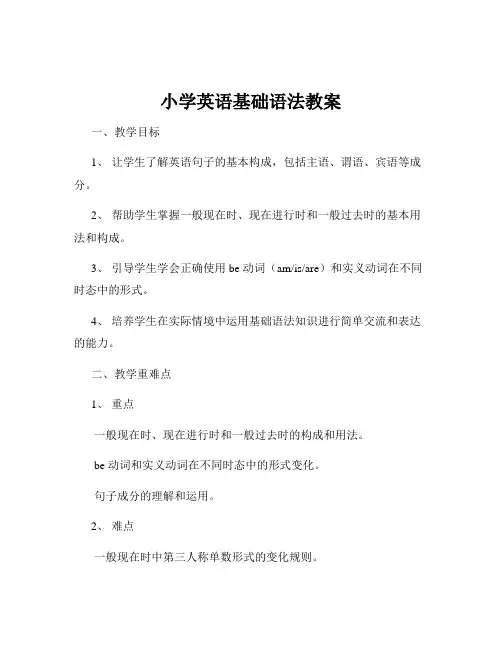
小学英语基础语法教案一、教学目标1、让学生了解英语句子的基本构成,包括主语、谓语、宾语等成分。
2、帮助学生掌握一般现在时、现在进行时和一般过去时的基本用法和构成。
3、引导学生学会正确使用 be 动词(am/is/are)和实义动词在不同时态中的形式。
4、培养学生在实际情境中运用基础语法知识进行简单交流和表达的能力。
二、教学重难点1、重点一般现在时、现在进行时和一般过去时的构成和用法。
be 动词和实义动词在不同时态中的形式变化。
句子成分的理解和运用。
2、难点一般现在时中第三人称单数形式的变化规则。
现在进行时中现在分词的构成规则。
不同时态在实际语境中的正确运用。
三、教学方法1、讲授法:讲解语法规则和知识点,让学生对基础语法有初步的了解。
2、练习法:通过练习题和造句等方式,让学生巩固所学的语法知识。
3、情境教学法:创设实际情境,让学生在情境中运用语法进行交流和表达。
四、教学过程1、导入(5 分钟)教师通过简单的英语对话,如问候、询问日常活动等,引出本节课要学习的语法内容。
例如:T: Good morning, class! How are you today? S: Fine, thank you! T: What do you do every day? 引导学生用简单的英语回答,从而发现学生在语法表达上的问题,引入本节课的主题。
2、知识讲解(20 分钟)句子成分讲解句子的基本成分,如主语、谓语、宾语等,并举例说明。
例如:“I love apples” 中,“I”是主语,“love”是谓语,“apples”是宾语。
一般现在时讲解一般现在时的定义、用法和构成。
强调当主语是第三人称单数时,动词要发生变化,如“he/she/it +动词第三人称单数形式”。
举例:“I play football every day” “He plays football every day”现在进行时介绍现在进行时的概念,表示正在进行的动作。
小学英语语法全英教案
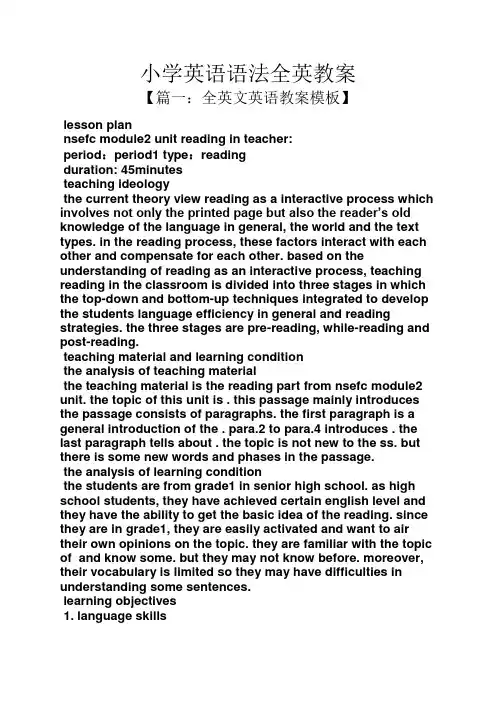
小学英语语法全英教案【篇一:全英文英语教案模板】lesson plannsefc module2 unit reading in teacher:period:period1 type:readingduration: 45minutesteaching ideologythe current theory view reading as a interactive process which involves not only the printed page but also the reader’s old knowledge of the language in general, the world and the text types. in the reading process, these factors interact with each other and compensate for each other. based on the understanding of reading as an interactive process, teaching reading in the classroom is divided into three stages in which the top-down and bottom-up techniques integrated to develop the students language efficiency in general and reading strategies. the three stages are pre-reading, while-reading and post-reading.teaching material and learning conditionthe analysis of teaching materialthe teaching material is the reading part from nsefc module2 unit. the topic of this unit is . this passage mainly introduces the passage consists of paragraphs. the first paragraph is a general introduction of the . para.2 to para.4 introduces . the last paragraph tells about . the topic is not new to the ss. but there is some new words and phases in the passage.the analysis of learning conditionthe students are from grade1 in senior high school. as high school students, they have achieved certain english level and they have the ability to get the basic idea of the reading. since they are in grade1, they are easily activated and want to air their own opinions on the topic. they are familiar with the topic of and know some. but they may not know before. moreover, their vocabulary is limited so they may have difficulties in understanding some sentences.learning objectives1. language skills? at the beginning of the class, ss can predict the content of the passage based on the title. ? ss can scan the passage and find out the specific information such as the person related with? ss can summarize the passage with the help of the clues of the passage.2. language knowledge? ss can master the key words and phrases of the passage as follows, . ? ss can learn , especially3. affects? ss will realize that and they will concern themselves with the issue of4. cultural awareness? ss will broaden their minds by knowing something about5. learning strategies? ss will cultivate their ability individual learning and cooperative learning by doing someactivities independently and some in groups.? ss will communicate with each other in english while doing the group work.language difficultiesfocuses and anticipatedlanguage focusesthis is a reading period so the focus is to cultivate the students’ reading skills. the many activities are designed to help ss to train their reading skills, such as predicting, skimming, scanning and summarizing.it is also important for the ss to master the new words and phrases.anticipated difficultiesas the ss have a limited vocabulary, so they may have some difficulties in understanding the passage. so the teacher will help them learn the new words and phrases.ss may did not heard before, so the teacher will tell them some background knowledge about it.teaching methodthree-stage model: based on the understanding of reading as an interactive process, teaching reading in the classroom is divided into three stages in which the top-down and bottom-up techniques integrated to develop the students languageefficiency in general and reading strategies. the three stages are pre-reading, while-reading and post-reading.teaching aidsmultimedia devices and ppt documents: in order to help ss to fully understand the whole passage, i adopt multimedia devices and ppt documents to bring the real-life situation into the classroom.teaching proceduresstep1. lead-in (6min)activity1. greetings and free-talking (2min)t leads into the topic by asking ss some they know. ss tell the name of the they know freely.t: hello boys and girls. (ss say hello to the teacher.)t: when we say , what appears in your minds? (ss tell the things appear in their minds freely.) t: what are the ? (ss tell some names of .)activity2. picture-talking (4min)t shows some pictures about the in china and abroad. after seeing the pictures, ss are expected to tell the similarities of them.t: just now, you talk about some in china. now, let’s see some pictures of some . (t shows the pictures and ss see them carefully.)t: what do the have in common?for example, they are very precious. what are your opinions?(t gives them some hints and ss tell the characteristics of )[aims]? in this step, t first leads in the topic by talking with the ss freely about the whichis familiar to them and then ss see some pictures and tell the characteristics. these two activities aim to arouse the ss’ interests in the topic and activate their old knowledge of . then ss will be mentally prepared for the reading comprehension. what’s more,when they are talking about the charateristics of, they will realize that theare rare and precious and they will concern themselves with the issue of .step2. pre-reading (3min)activity1. knowing something about (1min)t gives a brief introduction of the. ss will know the t: today, we are going to learn . it is . do you know what is? (t shows some pictures ofand ss get to know the .)activity2. predicting (2min)t asks ss to read the title of the passage and then ask them some questions. ss will predict the content of the passage with the help of the title.t: please look at the title “”, what does “” mean?(if the ss can not give the answer, then t explain it.)t: in search means that people are looking for it. why are people looking for it? can you guess? what will the passage talk about?(ss predict the content, but t will not give the answer here.)[aims]in this step, the ss first know some information of the ; the background information will make it easier for the ss to understand the passage. then t asks ss to make predictions about the passage. it aims to help ss develop the reading skills of predicting.step3. while-reading (22min)activity1. skimming (4min)ss skim the whole passage and find out and check their predictions. t: why are people still ? here is a multiple choice for you.activity2. scanning (3min)t presents several true or false statements and asks the ss to scan the passage and judge the right from the wrong.(keys: F,F,T,T,F)activity3 close-reading (15min)t designs various kinds of activities and ss do the activities to fully understand the passage. para.1t: please read para.1 carefully and then take some note about the .para.2-4please read para.2-4 carefully and then find out the removal of the room.please read para.2-4 carefully and then find out the person related with the amber room and the things them down with it. para.5please read para.5 carefully and then find out the the rebuilding of the amber room.【篇二:小学三年级英语教学设计(全英文版)】say open your books.point to the page“welcome to english”.what’s your known?listen and learn an english song:teaching aims of unit 1:1. grasp the new words: pencil-box eraser pencil bookruler bag crayon pen sharpener2. grasp the main sentences: hello! i’m?./ hi! i’m?.what’s your name? my name is?.goodbye./ bye. /see you.and get the students to use these sentences to communicate with each other.3. grasp the tpr activities in the part of “let’s do”.try to say these phrases and respond the actions correctly.5. learn to the part of “let’s chant”. understand the meaning of the chant and try to grasp the patterns “i have?.” and “ me too”.7. enable the students to understand the story in the part of “story time”. try to read and retell the story.lesson 1: a: let’s talk let’s playlesson 2: a: let’s learnlet’s dolesson 3: a: let’s makec: culturelet’s singlesson 4: b: let’s talk let’s playlesson 5: b: let’s learnlet’s do let’s singlesson 6: b: let’s check let’s chantc: story timelesson 1teaching aims:1.try to make a self-introduction with the pattern “ i’m?”.2.learn to use hello, hi, goodbye and bye to communicate with others.3.learn to sing a song: hellopreparation: recorder and tape.steps:(1). warm-up listen to the song: hello.(2). presentationa. teacher shows and introduces a new friend: a bear. “hello. i’m teddy. youcan call me teddy bear. ” goes to the pupils seat and greets to them, shakethe hands.b. ask pupils to practice this dialogue and later ask some pairs come to thefront to act.(3). presentationa. listen to the song: hello and pass a toy. if a child get the toy when thesong is stopping, he(she) say: hello(hi)! i’m?b. some children who haven’t got the toy stand up and introduce himself(herself):hello(hi)! i’m?(4). practiceteacher change the voice and make up like wear a pair of glasses. then teacher goes with teddy bear into the classroom, greets to one pupil with the dialogue above, and at last adds up a sentence: goodbye! practice and act the conversation in groups. then asks some groups to act it.(5). add-activitiesa. listen and read after the tape, imitate the tape.b. find a group of friends to make the conversation.lesson 2teaching aims:1. grasp the new words: pencil, crayon, eraser, ruler, pen and phrases: a pencil, a crayon, an eraser, a ruler, a pen.2. respond the tp r activities “show me your?”quickly and correctly. *try to use this phrase.*3. learn to say“i have a/an?” substitute the pattern with five new words. preparation:a. a teddy bearb. tape and recorderc. a pencil-box with a pen, a pencil, a ruler, an eraser, a crayon. steps:(1). warm-up/reviewa. listen to the song: hello.b. greets to pupils with: hello/hi. and hug them or shake hands.c. make a conversation like last lesson.(2). presentationa. show a pencil-box. let children guess : what is it in the pencil-box?(in chinese) then introduces to everybody like: yes! pencil. i have a pencil.b. use this form, let pupils guess and learn the words: pencil, pen, ruler, eraser, crayon.(3). practicea. game:say what is it in your pencil-box.-- i have a pen.b. teddy bear asks: what’s this in english? pupils say: eraser. do as this.(4). let’s doa. listen to the tape and teacher do it first t show the means.b. asks pupils to follow teacher to do it and say if they can.c. do it after tape like:-- show me your pencil. -- my pencil.(5). assessmentplay a bingo game with those words: crayon, pencil, eraser, ? lesson 3teaching aims:1.try to make a name card.2. enable the students to know some knowledge about teachers’ day and encourage them to say happy teachers’ day to other teachers.3. learn to sing a song: happy teachers’ day*4. make a teacher’s card and present the teacher you like.preparation:a. tape and recorderb. a name cardsteps:(1). warm-up/reviewa. listen to the song: happy teachers’ dayb. do it: show me your?(2). practicea. shows pupils a name card and asks pupils how can we make the name card.b. told pupils how can they make the name card in english.c. pupils make it by themselves and say how does he(she) make it in english.(3). enable the students to know some knowledge about teachers’ day: when isteachers’ day and encourage them to say happy teachers’ day to otherteachers.*make a teacher’s card and present the teacher you like. (4). let’s sing: happy teachers’ daylisten and sing the song.lesson 4teaching aims:1. get the students to grasp the sentences: what’s your name? my name is?.2. learn to use the phrase see you to express goodbye and try to use the word:welcome.3. practice and make dialogues about self-introduction.preparation:tape and recordersteps:(1). warm-up/ reviewa. sing the song: happy teachers’ dayb. make a greeting to each other.(2). presentationa. listen to the tape and then asks them what they heard.b. point to the name in a pupil’s book so that lets pupils know what’s meanof this sentence.c. asks pupils to practice this dialogue and later ask some pairs come to thefront to act.(3). practicemake a conversation, connect the texts in part a. (4). main picture back to the main picture, point and find what they are talking. then hand out the sortition paper to pupils. pupils get it and find what picture it is. and them imitate those visualizes, make a conversation according to the main picture: hello! i’m sarah. what’s your name? my name’s chen jie. goodbye! bye, miss white!(5). add-activities listen and read after tape and make the dialogue.lesson 5teaching aims:1.grasp the new words: bag, pencil-case, book, sharpener, school and the phrasesabag, a pencil-case, a book, a sharpener.2.respond the tpr activities quickly and correctly.*try to say “open/ close/ carry/ your ?”and “go to school”.*3.substitute the pattern “ i have a?”. learn to say and use the sentence “metoo!”.4.learn to sing a song: hellopreparation:a. tape and recorderb. a pencil-case, a bag, a book, a sharpener steps:(1). warm-up/reviewa. sing a song: happy teache rs’ dayb. do it (part a – lesson 2)(2). presentationa. let children guess: what is it?then introduces to everybody like: yes! bag. i have a bag.b. use this form, let pupils guess and learn the words: bag, book, pencil-case, sharpener, school.(3). practicea. asks: what’s this in english? pupils say: sharpener. do as this.b. game:say what is it?-- i have a bag. --me too!(4). let’s doa. listen to the tape and teacher do it first t show the means.b. asks pupils to follow teacher to do it and say if they can.c. guess and learn the word: school.(5). learn to sing a song: hello(6). assessmentplay a bingo game with those words: crayon, pencil, eraser, pen, ruler, bag, book, pencil-case, sharpener.lesson 6teaching aims:1. exercise in the part of “let’s check”.2. learn to say the part of “let’s chant”. perform it and replace it in theproper place.3. listen and watch a story about zip zoom. try to understand the meaning andtry to retell the story.4.review the new songs in the unit.preparation:a. tape and recorderb. some pictures for sortitionsteps:(1). warm-upa. sing a song: hellob. greet to each other.c. do it. (part b – lesson 2)(2). practicea. let’s chant.listen first and understand the means. then chant in pairs and act it.chant it together.b. let’s check.listen the tape and do it.(3). story timea. do as me: teacher do an action and pupils do the same and say it.b. when pupils finish saying, teddy bear and squirrel go into the classroom andact that story. those two pupils were teached yesterday by teacher.c. asks everyone to talking like the story showing.d. asks two to practice the dialogue. and then act it.(4). let’s sing: hello【篇三:小学英语语法教学设计】?? 小学英语语法教学设计小学低年级英语教学主要培养孩子学习英语的兴趣,注重课堂设计的真实性和实践性,因此在课堂教学中不能就语法而讲语法,对语法的教学应注重课堂活动和情景的创设,主要从以下几个方面来设计。
小学英语语法教案
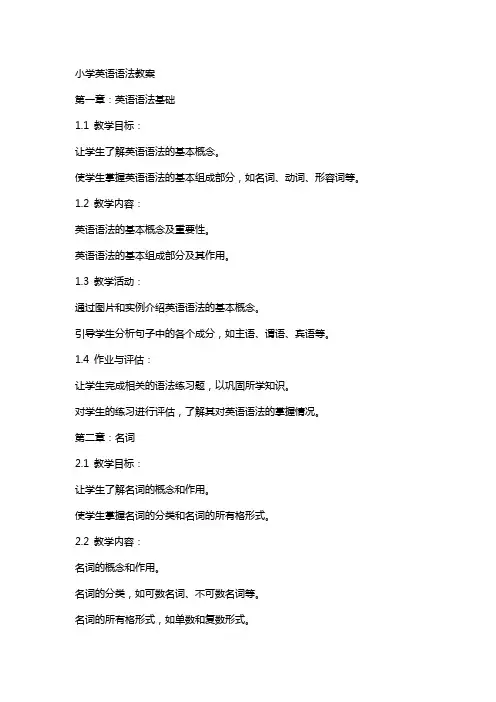
小学英语语法教案第一章:英语语法基础1.1 教学目标:让学生了解英语语法的基本概念。
使学生掌握英语语法的基本组成部分,如名词、动词、形容词等。
1.2 教学内容:英语语法的基本概念及重要性。
英语语法的基本组成部分及其作用。
1.3 教学活动:通过图片和实例介绍英语语法的基本概念。
引导学生分析句子中的各个成分,如主语、谓语、宾语等。
1.4 作业与评估:让学生完成相关的语法练习题,以巩固所学知识。
对学生的练习进行评估,了解其对英语语法的掌握情况。
第二章:名词2.1 教学目标:让学生了解名词的概念和作用。
使学生掌握名词的分类和名词的所有格形式。
2.2 教学内容:名词的概念和作用。
名词的分类,如可数名词、不可数名词等。
名词的所有格形式,如单数和复数形式。
2.3 教学活动:通过图片和实例介绍名词的概念和作用。
引导学生区分不同类型的名词。
讲解名词的所有格形式的用法。
2.4 作业与评估:让学生完成相关的名词练习题,以巩固所学知识。
对学生的练习进行评估,了解其对名词的掌握情况。
第三章:动词3.1 教学目标:让学生了解动词的概念和作用。
使学生掌握动词的时态和语态。
3.2 教学内容:动词的概念和作用。
动词的时态,如一般现在时、一般过去时、一般将来时等。
动词的语态,如主动语态、被动语态等。
3.3 教学活动:通过图片和实例介绍动词的概念和作用。
引导学生学习不态的动词用法。
讲解动词的语态及其用法。
3.4 作业与评估:让学生完成相关的动词练习题,以巩固所学知识。
对学生的练习进行评估,了解其对动词的掌握情况。
第四章:形容词4.1 教学目标:让学生了解形容词的概念和作用。
使学生掌握形容词的比较级和最高级。
4.2 教学内容:形容词的概念和作用。
形容词的比较级和最高级的构成及其用法。
4.3 教学活动:通过图片和实例介绍形容词的概念和作用。
引导学生学习形容词的比较级和最高级的构成。
讲解形容词的比较级和最高级的用法。
4.4 作业与评估:让学生完成相关的形容词练习题,以巩固所学知识。
小学英语教语法的教案模板
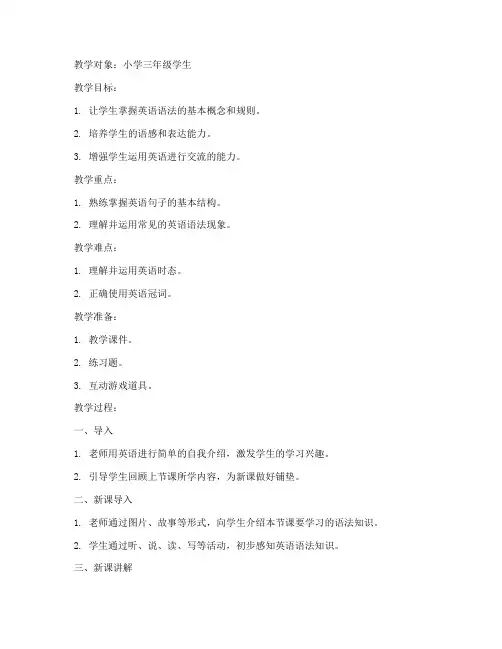
教学对象:小学三年级学生教学目标:1. 让学生掌握英语语法的基本概念和规则。
2. 培养学生的语感和表达能力。
3. 增强学生运用英语进行交流的能力。
教学重点:1. 熟练掌握英语句子的基本结构。
2. 理解并运用常见的英语语法现象。
教学难点:1. 理解并运用英语时态。
2. 正确使用英语冠词。
教学准备:1. 教学课件。
2. 练习题。
3. 互动游戏道具。
教学过程:一、导入1. 老师用英语进行简单的自我介绍,激发学生的学习兴趣。
2. 引导学生回顾上节课所学内容,为新课做好铺垫。
二、新课导入1. 老师通过图片、故事等形式,向学生介绍本节课要学习的语法知识。
2. 学生通过听、说、读、写等活动,初步感知英语语法知识。
三、新课讲解1. 老师结合具体例句,讲解英语句子的基本结构,如主语、谓语、宾语等。
2. 学生跟读、模仿,巩固所学知识。
3. 老师讲解英语时态的概念和用法,如一般现在时、一般过去时、一般将来时等。
4. 学生通过练习,掌握英语时态的运用。
5. 老师讲解英语冠词的概念和用法,如a/an、the等。
6. 学生通过练习,掌握英语冠词的运用。
四、巩固练习1. 老师出示练习题,让学生进行口头或书面练习。
2. 学生分组讨论,互相检查练习结果。
3. 老师针对学生的练习情况,进行个别辅导。
五、课堂小结1. 老师总结本节课所学内容,强调重点和难点。
2. 学生分享自己的学习心得,巩固所学知识。
六、作业布置1. 完成课后练习题。
2. 预习下一节课的内容。
教学反思:1. 教师在讲解英语语法知识时,要注意结合具体例句,让学生在实践中掌握知识。
2. 教师要关注学生的个体差异,针对不同学生的学习情况,给予个别辅导。
3. 教师要善于运用多种教学手段,激发学生的学习兴趣,提高课堂教学效果。
4. 教师要注重培养学生的语感和表达能力,为学生的英语学习奠定基础。
小学英语语法教案
小学英语语法教案一、教学目标:1. 知识目标:让学生掌握小学阶段基本的英语语法知识,如名词、动词、形容词、副词等词性的用法。
2. 能力目标:培养学生能够正确运用所学生词进行简单的句子表达,提高学生的英语写作和口语能力。
3. 情感目标:激发学生学习英语语法的兴趣,培养他们积极的学习态度。
二、教学内容:1. 第一课时:名词的用法1.1 学习名词的单数和复数形式。
1.2 掌握名词的所有格形式。
1.3 练习运用名词进行句子表达。
2. 第二课时:动词的用法2.1 学习动词的现在时态。
2.2 掌握动词的过去时态。
2.3 练习运用动词进行句子表达。
3. 第三课时:形容词和副词的用法3.1 学习形容词和副词的比较级和最高级。
3.2 掌握形容词和副词在句子中的位置。
3.3 练习运用形容词和副词进行句子表达。
4. 第四课时:简单句的结构4.1 学习主谓宾结构。
4.2 掌握主谓表结构。
4.3 练习运用简单句进行句子表达。
5. 第五课时:标点符号的用法5.1 学习英文句子的基本标点符号。
5.2 掌握标点符号的正确使用方法。
5.3 练习运用标点符号进行句子表达。
三、教学方法:1. 采用任务型教学法,通过小组合作、互动交流的方式,激发学生的学习兴趣。
2. 运用直观演示法,让学生在实际操作中感受和理解语法知识。
3. 采用情境教学法,创设真实的语境,让学生在实践中运用所学语法知识。
4. 利用多媒体教学手段,丰富教学内容,提高学生的学习兴趣。
四、教学评价:1. 课堂表现评价:观察学生在课堂上的参与程度、合作意识和表达能力。
2. 作业评价:检查学生完成作业的质量,巩固所学语法知识。
3. 测试评价:定期进行语法知识测试,了解学生的掌握情况。
五、教学资源:1. 教材:人教版《小学英语》课本。
2. 辅助材料:PPT、单词卡片、练习册等。
3. 教学设备:投影仪、电脑、音响等。
4. 网络资源:英语学习网站、动画片、儿歌等。
六、第六课时:介词的用法6.1 学习基本介词(如in, on, at, with, under, over等)的用法。
英语语法教案模板小学
教学目标:1. 让学生掌握一般现在时的基本用法和构成。
2. 能够正确运用一般现在时描述日常生活中的事物和动作。
3. 培养学生的英语语感和语法意识。
教学对象:小学四年级教学时间:2课时教学重点:1. 一般现在时的构成和用法。
2. 一般现在时的疑问句和否定句。
教学难点:1. 一般现在时与现在进行时的区别。
2. 一般现在时疑问句和否定句的构成。
教学准备:1. 教学课件2. 英文卡片3. 练习册4. 多媒体设备教学过程:第一课时一、导入1. 通过图片、实物或情境,引导学生思考并描述身边的事物或动作。
2. 提问:“How do you say...in English?”,让学生用英语描述。
二、新课讲解1. 介绍一般现在时的构成:主语 + 动词原形。
2. 通过例句讲解一般现在时的用法,如:“I like apples.”、“She eats breakfast at 7:00.”3. 引导学生观察一般现在时疑问句和否定句的构成,如:“Do you like apples?”、“I don’t like apples.”三、课堂练习1. 随机抽取学生用一般现在时描述身边的事物或动作。
2. 学生两人一组,互相提问并回答一般现在时的问题。
3. 教师展示卡片,让学生根据卡片内容,用一般现在时提问。
四、小结1. 总结一般现在时的构成和用法。
2. 强调一般现在时疑问句和否定句的构成。
第二课时一、复习1. 通过游戏或竞赛,让学生复习一般现在时的构成和用法。
2. 教师提问,学生回答,巩固一般现在时的知识点。
二、新课讲解1. 介绍一般现在时与现在进行时的区别,如:“I eat breakfast at 7:00.”(现在进行时)与“I eat breakfast at 7:00.”(一般现在时)的区别。
2. 通过例句讲解一般现在时疑问句和否定句的构成,如:“Do you like apples?”、“I don’t like apples.”三、课堂练习1. 学生根据教师给出的句子,判断其是一般现在时还是现在进行时。
英语小学语法精讲教案模板
教学目标:1. 让学生掌握一般现在时态的构成和用法。
2. 培养学生运用一般现在时态进行简单对话和写作的能力。
3. 增强学生对英语语法的兴趣,提高学生的英语综合运用能力。
教学对象:小学四年级学生教学时长:2课时教学准备:1. 教学挂图:展示一般现在时态的构成和用法。
2. 教学投影片:展示一般现在时态的例句和练习题。
3. 教学录音磁带:播放一般现在时态的例句和对话。
4. 学生准备:准备与一般现在时态相关的词汇卡片。
教学过程:第一课时一、导入1. 教师与学生用英语进行简单的问候和交流,引入本节课的主题。
2. 教师展示一般现在时态的构成和用法挂图,引导学生关注时态的变化。
二、新课讲解1. 教师详细讲解一般现在时态的构成:主语 + 动词原形。
2. 通过例句展示一般现在时态的用法,如:I like reading books.(我喜欢读书。
)3. 强调动词的变化规则,如:am, is, are 等系动词的使用。
三、练习巩固1. 教师播放一般现在时态的录音,学生跟读并模仿。
2. 学生分组进行一般现在时态的对话练习,教师巡回指导。
3. 教师出示一般现在时态的练习题,学生独立完成。
四、课堂小结1. 教师对本节课的重点内容进行总结,强调一般现在时态的构成和用法。
2. 学生分享自己在练习中的收获和困惑。
第二课时一、复习导入1. 教师检查学生上节课的作业,了解学生对一般现在时态的掌握情况。
2. 教师带领学生回顾一般现在时态的构成和用法。
二、新课讲解1. 教师讲解一般现在时态在写作中的应用,如:描述人物、地点、事物等。
2. 通过例文展示一般现在时态在写作中的运用,如:My family lives in a small town.(我的家人住在一个小镇。
)3. 强调动词变化规则在写作中的重要性。
三、练习巩固1. 学生根据所学知识,独立完成一篇一般现在时态的短文。
2. 教师选取优秀作品进行展示和点评。
四、课堂小结1. 教师对本节课的重点内容进行总结,强调一般现在时态在写作中的应用。
英语语法教学设计教案
英语语法教学设计教案【篇一:小学英语语法教学设计】?? 小学英语语法教学设计小学低年级英语教学主要培养孩子学习英语的兴趣,注重课堂设计的真实性和实践性,因此在课堂教学中不能就语法而讲语法,对语法的教学应注重课堂活动和情景的创设,主要从以下几个方面来设计。
(1)在情景性活动中感悟语法直观的教学情境能使抽象的知识变为形象的知识,静态的知识变为动态的知识。
语法教学中语法概念和语法规则是抽象乏味的,对小学生来说没有太大的吸引力,如果单用教师的讲解去解释和说明语法现象,或者让学生死记硬背,久而久之学生学习英语的热情就会慢慢地消退。
语法教学上,英国专家提倡让孩子在一个有意义的情景中理解所教语法项目的意义;然后,提供足够的机会让孩子在比较真实的语境中进行交际性活动,运用所学的语法项目;例如:教师再教助动词be的人称形式(am, is, are)+动词的ing形式构成时,可请几个男女同学上台和老师一起画画。
t: i’m drawing pictures. what are you doing, tom?tom: i’m drawing pictures, too.t: what is she doing? (pointing to amy)ss: she is drawing pictures.t: what is he doing? (pointing to ben)ss: he is drawing pictures.t: what are tom, amy and ben doing?(pointing to tom, amy and ben) ss: they are drawing pictures.教师重复之后板书:what are you doing? i’m…what is he doing? he is…what is she doing? she is…what are they doing? they are…通过情景教学,语法学习变得生动而有趣,学生也学得快,记得牢,用得活。
- 1、下载文档前请自行甄别文档内容的完整性,平台不提供额外的编辑、内容补充、找答案等附加服务。
- 2、"仅部分预览"的文档,不可在线预览部分如存在完整性等问题,可反馈申请退款(可完整预览的文档不适用该条件!)。
- 3、如文档侵犯您的权益,请联系客服反馈,我们会尽快为您处理(人工客服工作时间:9:00-18:30)。
The 4th week the 3rd plan
Teaching aims
1Teaching the students to practice how to introduce other person or something with the adjectives.
2 Students will be able to understand and master the usage of some important words/phrases and sentences pattern.
3 Students will be able to practice their careful reading skill and information converting skill.
3According to this lesson, let students to know how to use it. Not only for the study, but also for the realized. Let the students to know there are many beautiful things in the world.
4 Help the students to train the ability of using the rules Teaching important point
1Teaching the students to practice how to introduce other person or something with the adjectives.
2 Students will be able to understand and master the usage of some important words/phrases and sentences pattern.
3 Students will be able to practice their careful reading skill and information converting skill.
Teaching difficult point
1Teaching the students to practice how to introduce other person or something with the adjectives.
2 Students will be able to understand and master the usage of some important words/phrases and sentences pattern.
3 Students will be able to practice their careful reading skill and information converting skill.
Teaching aids
Students book P126-127 blackboard
Teaching Procedures
Step 1 Greeting and warming up
1 warming up:
T: Do you like travelling
S: …
T: Where have you already visited?
S: …
T: Have you ever been to Europe?
S: …
T: Therefore, you will have a feast for your eyes. Let’s watch a video about Europe. While you are watching, please write down at least two names of countries and cities that you’ve heard in this video. (English is welcome. If you can’t, Chinese is also acceptable.)
Step 2 plays the video and check answers
Stage 3 While-stage
Step 1: ask students to complete the table with the words in The box in exercise 1 and learning the vocabulary while Checking the answer
(The best one can get one point)
Step 2: ask students to read the information and find the countries on the map above in exercise 2
(f) 1 The United Kingdom is off the northwest coast of
continental Europe. It has four countries with one
government. These countries are England, Northern
Ireland, and Wales.
(a) 2 France is Europe’s third largest country and faces
the United Kingdom across the English Channel.
(c) 3 Italy is in the south of Europe on the coast of the
Mediterranean Sea. It looks like a boot. Between Italy
and France, there is a mountain range called Alps.
(e) 4 Spain is to the south of France. Between France and
Spain is another mountain range—the Pyrenees.
(d) 5 Portugal is to the west of Spain.
(b) 6 Greece is in the southeast of Europe. Twenty percent
of the country is covered by islands.
(This lesson is talking about many countries. So the
teacher needs to use many pictures and PPT to help
students to remember.)
Stage 4 Post-stage
Step1. ask students to describe one of their favorite country on the map according to what we have learnt today(name/capital/language/location/features)
Step2. Invite students to appreciate the beautiful scenery of Europe to the light music
Summary
This lesson, let the students to know how to describe a country and let the students will be able to understand and master the usage of some important words/phrases and sentences pattern. Also let them to know there are many beautiful things in the world.
Step4 Homework
1 Prepare the P127-128
2Copy the text on P126 for three times. Step5 Blackboard design
T: Do you like travelling
S: …
T: Where have you already visited?
S: …
T: Have you ever been to Europe?
S: …
Reflection。
